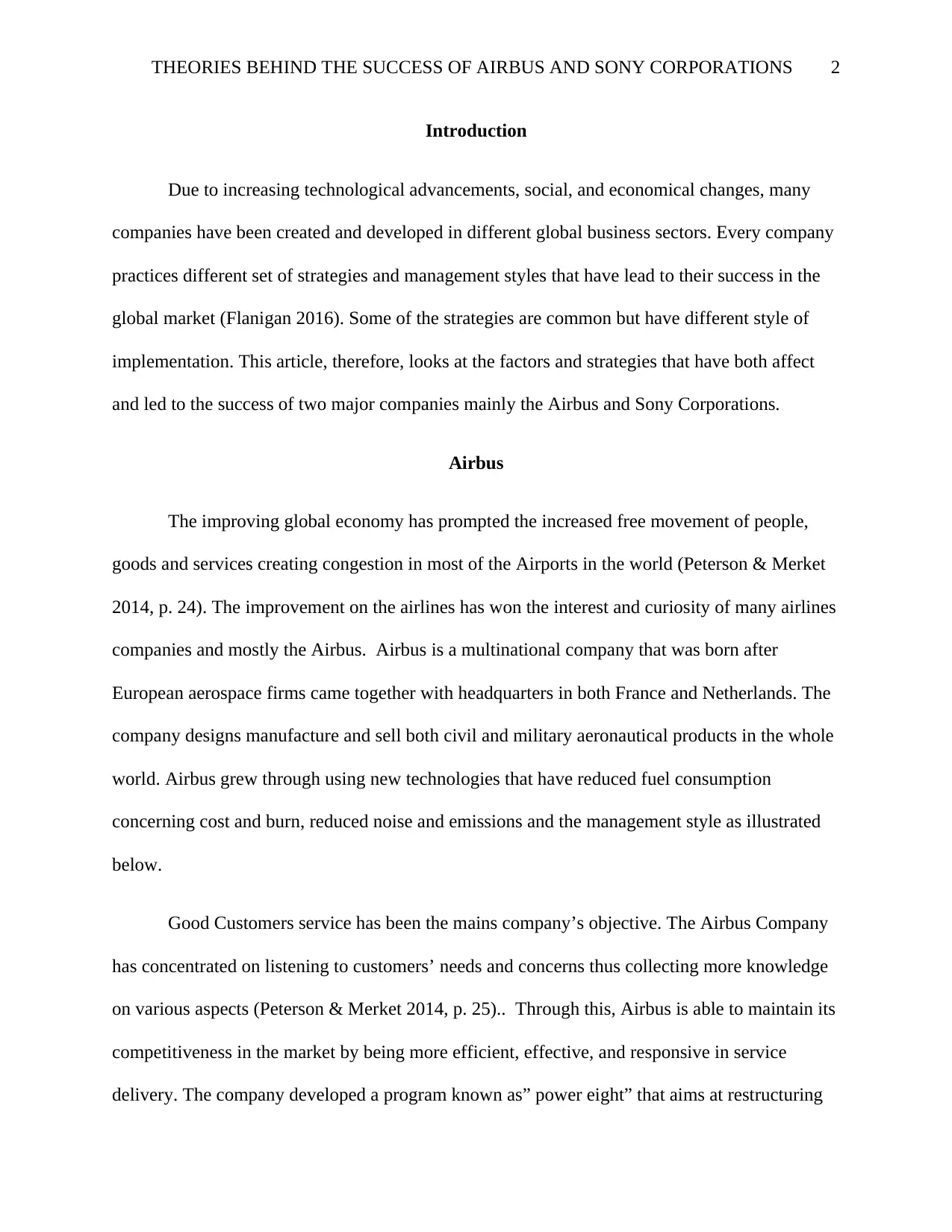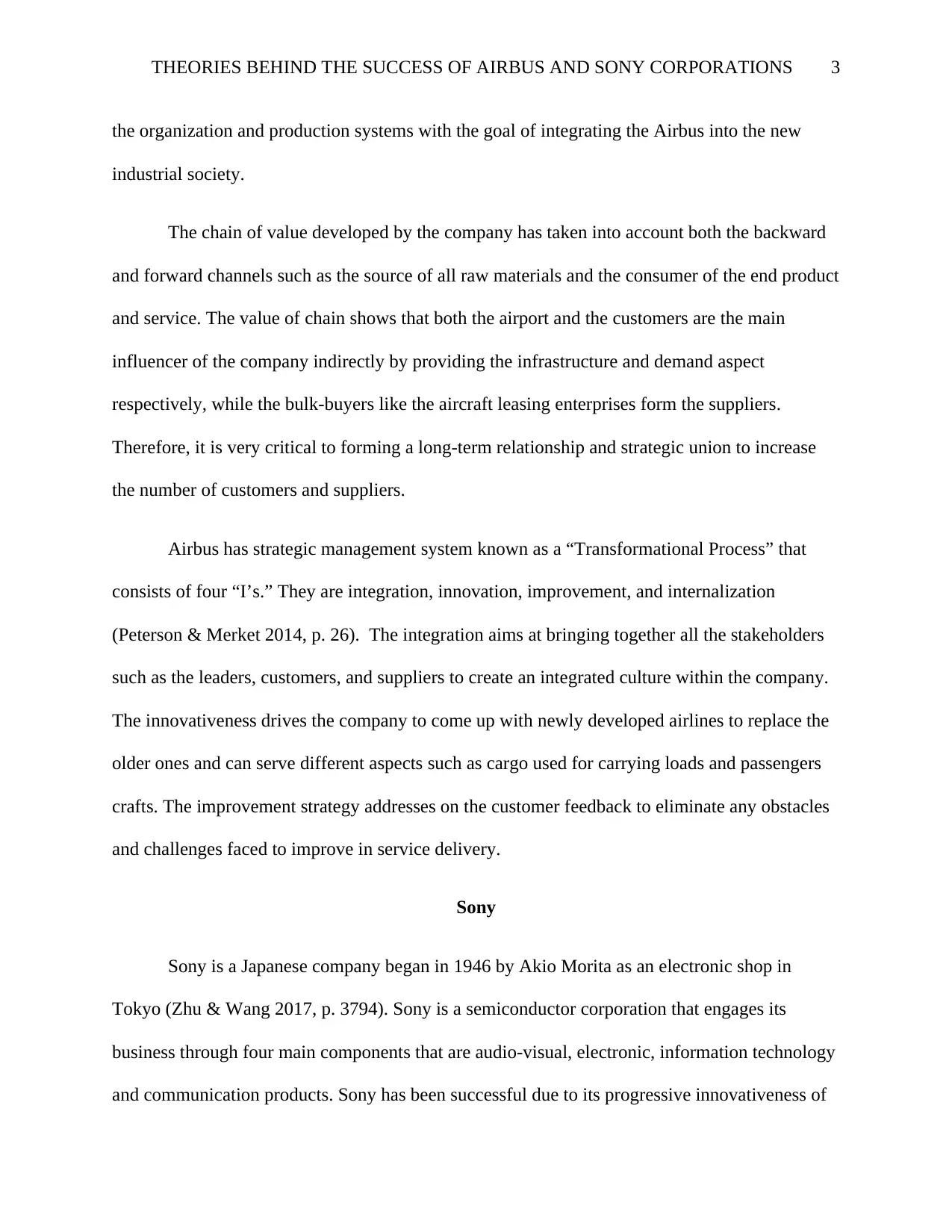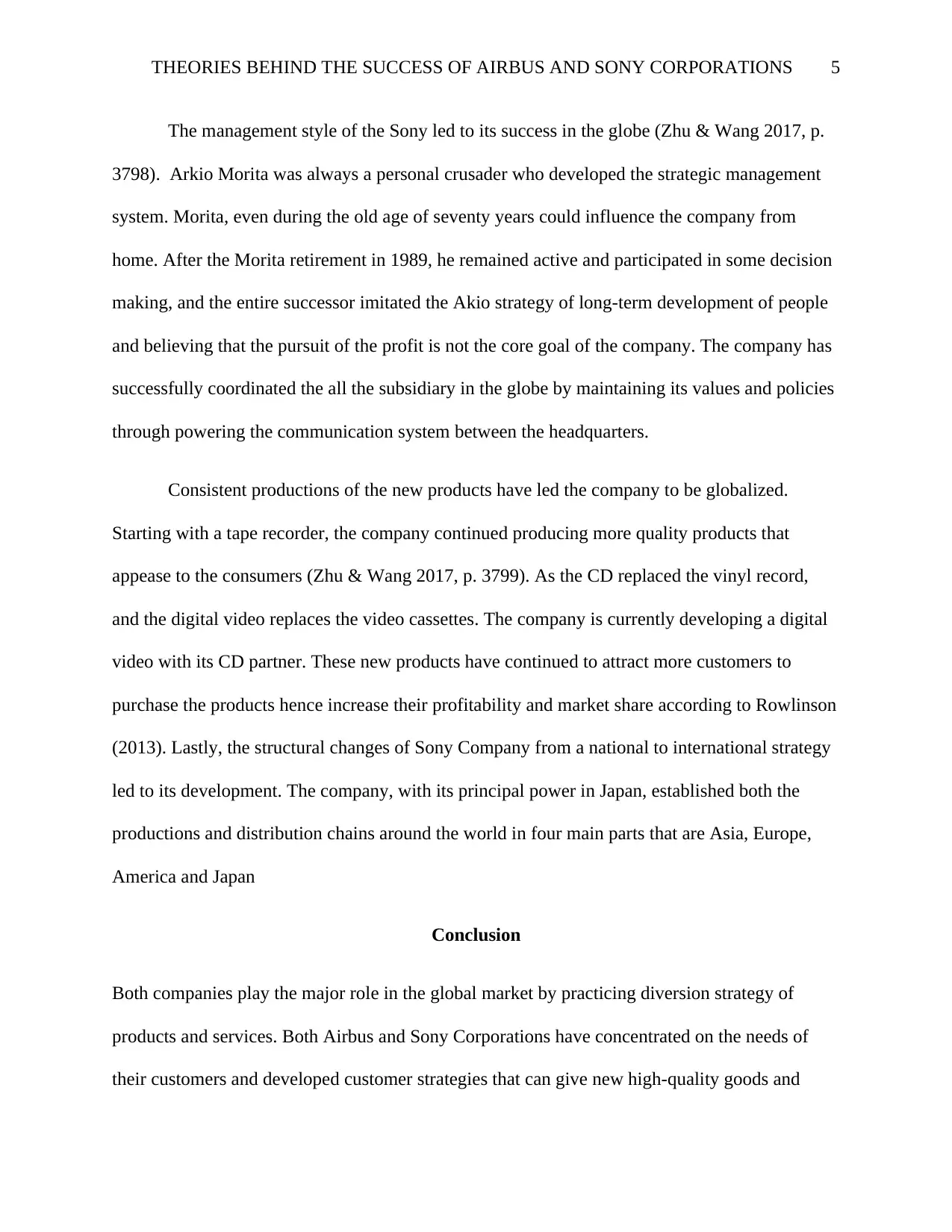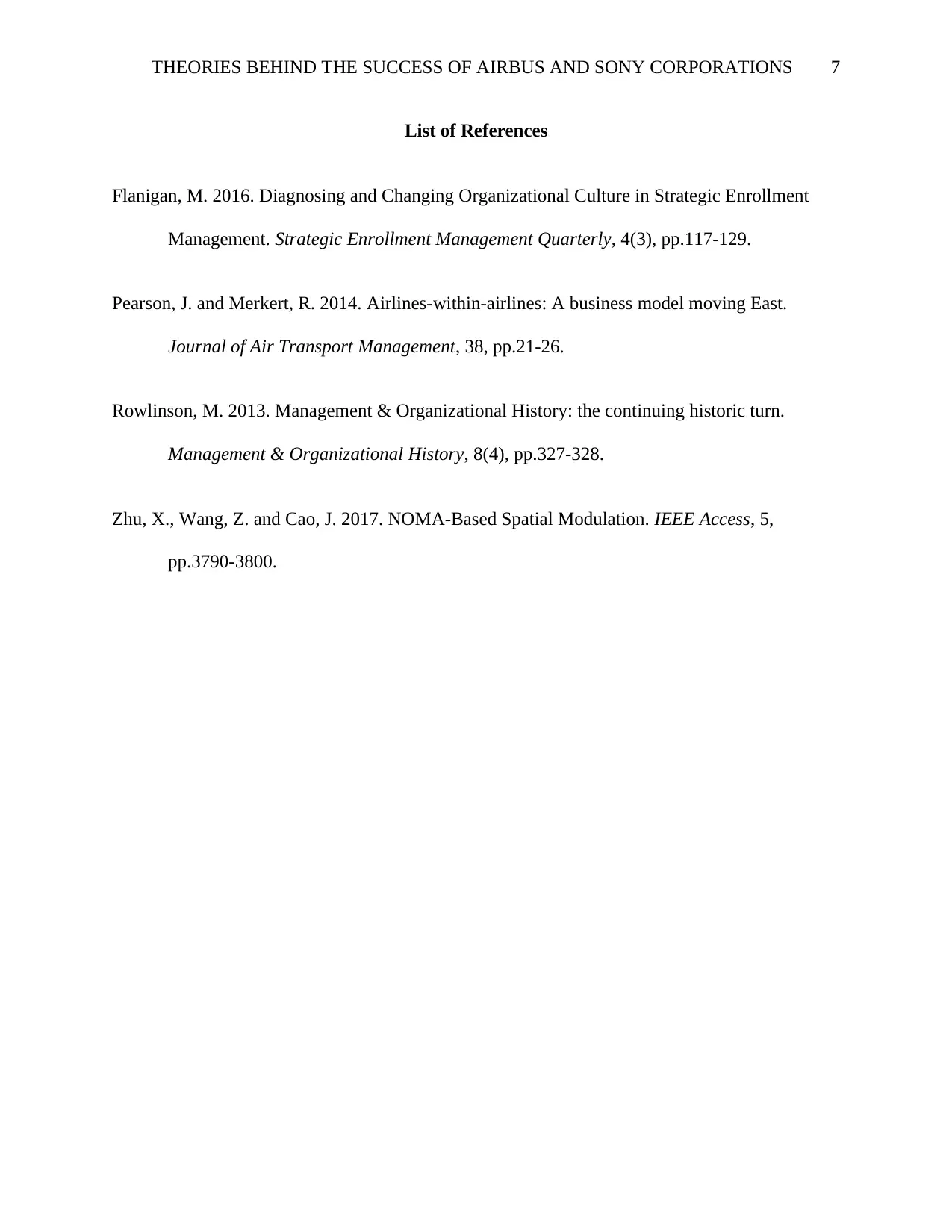Business Performance Analysis: Airbus and Sony Corporations' Success
VerifiedAdded on 2020/03/04
|7
|1452
|57
Report
AI Summary
This report examines the factors and strategies that have contributed to the success of Airbus and Sony Corporations. It begins by analyzing Airbus, a multinational company that has thrived through customer service, technological innovation, and a "Transformational Process" integrating stakeholders. The analysis then shifts to Sony, a Japanese corporation that achieved success through product innovation, risk management, and a strategic management system pioneered by Akio Morita. The report highlights Sony's ability to adapt to changing markets and maintain a global presence through consistent production of new products and structural changes. Both companies are seen as major players in the global market, focusing on customer needs and product diversification. The report concludes by emphasizing the importance of market participation and innovativeness towards customer satisfaction as key drivers of their success.

Business Performance 1
THEORIES BEHIND THE SUCCESS OF AIRBUS AND SONY CORPORATION
Name:
Institution:
Course:
Tutor:
Date:
THEORIES BEHIND THE SUCCESS OF AIRBUS AND SONY CORPORATION
Name:
Institution:
Course:
Tutor:
Date:
Paraphrase This Document
Need a fresh take? Get an instant paraphrase of this document with our AI Paraphraser

THEORIES BEHIND THE SUCCESS OF AIRBUS AND SONY CORPORATIONS 2
Introduction
Due to increasing technological advancements, social, and economical changes, many
companies have been created and developed in different global business sectors. Every company
practices different set of strategies and management styles that have lead to their success in the
global market (Flanigan 2016). Some of the strategies are common but have different style of
implementation. This article, therefore, looks at the factors and strategies that have both affect
and led to the success of two major companies mainly the Airbus and Sony Corporations.
Airbus
The improving global economy has prompted the increased free movement of people,
goods and services creating congestion in most of the Airports in the world (Peterson & Merket
2014, p. 24). The improvement on the airlines has won the interest and curiosity of many airlines
companies and mostly the Airbus. Airbus is a multinational company that was born after
European aerospace firms came together with headquarters in both France and Netherlands. The
company designs manufacture and sell both civil and military aeronautical products in the whole
world. Airbus grew through using new technologies that have reduced fuel consumption
concerning cost and burn, reduced noise and emissions and the management style as illustrated
below.
Good Customers service has been the mains company’s objective. The Airbus Company
has concentrated on listening to customers’ needs and concerns thus collecting more knowledge
on various aspects (Peterson & Merket 2014, p. 25).. Through this, Airbus is able to maintain its
competitiveness in the market by being more efficient, effective, and responsive in service
delivery. The company developed a program known as” power eight” that aims at restructuring
Introduction
Due to increasing technological advancements, social, and economical changes, many
companies have been created and developed in different global business sectors. Every company
practices different set of strategies and management styles that have lead to their success in the
global market (Flanigan 2016). Some of the strategies are common but have different style of
implementation. This article, therefore, looks at the factors and strategies that have both affect
and led to the success of two major companies mainly the Airbus and Sony Corporations.
Airbus
The improving global economy has prompted the increased free movement of people,
goods and services creating congestion in most of the Airports in the world (Peterson & Merket
2014, p. 24). The improvement on the airlines has won the interest and curiosity of many airlines
companies and mostly the Airbus. Airbus is a multinational company that was born after
European aerospace firms came together with headquarters in both France and Netherlands. The
company designs manufacture and sell both civil and military aeronautical products in the whole
world. Airbus grew through using new technologies that have reduced fuel consumption
concerning cost and burn, reduced noise and emissions and the management style as illustrated
below.
Good Customers service has been the mains company’s objective. The Airbus Company
has concentrated on listening to customers’ needs and concerns thus collecting more knowledge
on various aspects (Peterson & Merket 2014, p. 25).. Through this, Airbus is able to maintain its
competitiveness in the market by being more efficient, effective, and responsive in service
delivery. The company developed a program known as” power eight” that aims at restructuring

THEORIES BEHIND THE SUCCESS OF AIRBUS AND SONY CORPORATIONS 3
the organization and production systems with the goal of integrating the Airbus into the new
industrial society.
The chain of value developed by the company has taken into account both the backward
and forward channels such as the source of all raw materials and the consumer of the end product
and service. The value of chain shows that both the airport and the customers are the main
influencer of the company indirectly by providing the infrastructure and demand aspect
respectively, while the bulk-buyers like the aircraft leasing enterprises form the suppliers.
Therefore, it is very critical to forming a long-term relationship and strategic union to increase
the number of customers and suppliers.
Airbus has strategic management system known as a “Transformational Process” that
consists of four “I’s.” They are integration, innovation, improvement, and internalization
(Peterson & Merket 2014, p. 26). The integration aims at bringing together all the stakeholders
such as the leaders, customers, and suppliers to create an integrated culture within the company.
The innovativeness drives the company to come up with newly developed airlines to replace the
older ones and can serve different aspects such as cargo used for carrying loads and passengers
crafts. The improvement strategy addresses on the customer feedback to eliminate any obstacles
and challenges faced to improve in service delivery.
Sony
Sony is a Japanese company began in 1946 by Akio Morita as an electronic shop in
Tokyo (Zhu & Wang 2017, p. 3794). Sony is a semiconductor corporation that engages its
business through four main components that are audio-visual, electronic, information technology
and communication products. Sony has been successful due to its progressive innovativeness of
the organization and production systems with the goal of integrating the Airbus into the new
industrial society.
The chain of value developed by the company has taken into account both the backward
and forward channels such as the source of all raw materials and the consumer of the end product
and service. The value of chain shows that both the airport and the customers are the main
influencer of the company indirectly by providing the infrastructure and demand aspect
respectively, while the bulk-buyers like the aircraft leasing enterprises form the suppliers.
Therefore, it is very critical to forming a long-term relationship and strategic union to increase
the number of customers and suppliers.
Airbus has strategic management system known as a “Transformational Process” that
consists of four “I’s.” They are integration, innovation, improvement, and internalization
(Peterson & Merket 2014, p. 26). The integration aims at bringing together all the stakeholders
such as the leaders, customers, and suppliers to create an integrated culture within the company.
The innovativeness drives the company to come up with newly developed airlines to replace the
older ones and can serve different aspects such as cargo used for carrying loads and passengers
crafts. The improvement strategy addresses on the customer feedback to eliminate any obstacles
and challenges faced to improve in service delivery.
Sony
Sony is a Japanese company began in 1946 by Akio Morita as an electronic shop in
Tokyo (Zhu & Wang 2017, p. 3794). Sony is a semiconductor corporation that engages its
business through four main components that are audio-visual, electronic, information technology
and communication products. Sony has been successful due to its progressive innovativeness of
⊘ This is a preview!⊘
Do you want full access?
Subscribe today to unlock all pages.

Trusted by 1+ million students worldwide

THEORIES BEHIND THE SUCCESS OF AIRBUS AND SONY CORPORATIONS 4
products that has been facilitated by increasing significance of computers and communication
equipment. The growing need forced Sony to focus their thinking and research on the
technological aspects of communication. The company’s first product was the tape recorder
when he realized the potential of the machine. The process of manufacturing the tapes was the
shortage of the plastic bags in Japan. The company, therefore, opted to produce the reel-to-reel
tapes. The law against the importation of the plastic bags from abroad created the shortage of the
plastic bags. The company tried so many ways such as cellophane, rice paper and calendared
paper with the smooth surface which was coatable with magnetic powder. Later the company
overcame the problem of the paper through building a superior quality into circulatory, recording
head and amplification system. The company then produced transistor radios and continued
innovating into more consumer electronics such as television and mobile phones.
The company was very able to manage their risks that came with its ways, such as
managing American acquisition (Zhu & Wang 2017, p. 3796). Sony being a Japan company was
controlled by Americans whom they recruited to control the company. The whole entertainment
company, therefore, was being controlled from Hollywood by an American known as Mickey
Schulhof till 1915. The company has recruited more European and American managers
afterward bringing into different cultures in the company that has strengthened it. Therefore the
company thought to give the Americans freedom to control their businesses. The second risk
management aspect was political. The company experienced a hostile reaction from the public
because of being well developed and renowned in the United States. The third risk was the
strategic risk. Sony Company departed with a lot of money to develop its software’s. The
company had to make its hardware’s to be available to all software’s producers since it could not
control the purchases of the software’s.
products that has been facilitated by increasing significance of computers and communication
equipment. The growing need forced Sony to focus their thinking and research on the
technological aspects of communication. The company’s first product was the tape recorder
when he realized the potential of the machine. The process of manufacturing the tapes was the
shortage of the plastic bags in Japan. The company, therefore, opted to produce the reel-to-reel
tapes. The law against the importation of the plastic bags from abroad created the shortage of the
plastic bags. The company tried so many ways such as cellophane, rice paper and calendared
paper with the smooth surface which was coatable with magnetic powder. Later the company
overcame the problem of the paper through building a superior quality into circulatory, recording
head and amplification system. The company then produced transistor radios and continued
innovating into more consumer electronics such as television and mobile phones.
The company was very able to manage their risks that came with its ways, such as
managing American acquisition (Zhu & Wang 2017, p. 3796). Sony being a Japan company was
controlled by Americans whom they recruited to control the company. The whole entertainment
company, therefore, was being controlled from Hollywood by an American known as Mickey
Schulhof till 1915. The company has recruited more European and American managers
afterward bringing into different cultures in the company that has strengthened it. Therefore the
company thought to give the Americans freedom to control their businesses. The second risk
management aspect was political. The company experienced a hostile reaction from the public
because of being well developed and renowned in the United States. The third risk was the
strategic risk. Sony Company departed with a lot of money to develop its software’s. The
company had to make its hardware’s to be available to all software’s producers since it could not
control the purchases of the software’s.
Paraphrase This Document
Need a fresh take? Get an instant paraphrase of this document with our AI Paraphraser

THEORIES BEHIND THE SUCCESS OF AIRBUS AND SONY CORPORATIONS 5
The management style of the Sony led to its success in the globe (Zhu & Wang 2017, p.
3798). Arkio Morita was always a personal crusader who developed the strategic management
system. Morita, even during the old age of seventy years could influence the company from
home. After the Morita retirement in 1989, he remained active and participated in some decision
making, and the entire successor imitated the Akio strategy of long-term development of people
and believing that the pursuit of the profit is not the core goal of the company. The company has
successfully coordinated the all the subsidiary in the globe by maintaining its values and policies
through powering the communication system between the headquarters.
Consistent productions of the new products have led the company to be globalized.
Starting with a tape recorder, the company continued producing more quality products that
appease to the consumers (Zhu & Wang 2017, p. 3799). As the CD replaced the vinyl record,
and the digital video replaces the video cassettes. The company is currently developing a digital
video with its CD partner. These new products have continued to attract more customers to
purchase the products hence increase their profitability and market share according to Rowlinson
(2013). Lastly, the structural changes of Sony Company from a national to international strategy
led to its development. The company, with its principal power in Japan, established both the
productions and distribution chains around the world in four main parts that are Asia, Europe,
America and Japan
Conclusion
Both companies play the major role in the global market by practicing diversion strategy of
products and services. Both Airbus and Sony Corporations have concentrated on the needs of
their customers and developed customer strategies that can give new high-quality goods and
The management style of the Sony led to its success in the globe (Zhu & Wang 2017, p.
3798). Arkio Morita was always a personal crusader who developed the strategic management
system. Morita, even during the old age of seventy years could influence the company from
home. After the Morita retirement in 1989, he remained active and participated in some decision
making, and the entire successor imitated the Akio strategy of long-term development of people
and believing that the pursuit of the profit is not the core goal of the company. The company has
successfully coordinated the all the subsidiary in the globe by maintaining its values and policies
through powering the communication system between the headquarters.
Consistent productions of the new products have led the company to be globalized.
Starting with a tape recorder, the company continued producing more quality products that
appease to the consumers (Zhu & Wang 2017, p. 3799). As the CD replaced the vinyl record,
and the digital video replaces the video cassettes. The company is currently developing a digital
video with its CD partner. These new products have continued to attract more customers to
purchase the products hence increase their profitability and market share according to Rowlinson
(2013). Lastly, the structural changes of Sony Company from a national to international strategy
led to its development. The company, with its principal power in Japan, established both the
productions and distribution chains around the world in four main parts that are Asia, Europe,
America and Japan
Conclusion
Both companies play the major role in the global market by practicing diversion strategy of
products and services. Both Airbus and Sony Corporations have concentrated on the needs of
their customers and developed customer strategies that can give new high-quality goods and

THEORIES BEHIND THE SUCCESS OF AIRBUS AND SONY CORPORATIONS 6
services over an extended years. Therefore, the success companies stand at their capability to
participate well in the market and their innovativeness towards customer satisfaction.
services over an extended years. Therefore, the success companies stand at their capability to
participate well in the market and their innovativeness towards customer satisfaction.
⊘ This is a preview!⊘
Do you want full access?
Subscribe today to unlock all pages.

Trusted by 1+ million students worldwide

THEORIES BEHIND THE SUCCESS OF AIRBUS AND SONY CORPORATIONS 7
List of References
Flanigan, M. 2016. Diagnosing and Changing Organizational Culture in Strategic Enrollment
Management. Strategic Enrollment Management Quarterly, 4(3), pp.117-129.
Pearson, J. and Merkert, R. 2014. Airlines-within-airlines: A business model moving East.
Journal of Air Transport Management, 38, pp.21-26.
Rowlinson, M. 2013. Management & Organizational History: the continuing historic turn.
Management & Organizational History, 8(4), pp.327-328.
Zhu, X., Wang, Z. and Cao, J. 2017. NOMA-Based Spatial Modulation. IEEE Access, 5,
pp.3790-3800.
List of References
Flanigan, M. 2016. Diagnosing and Changing Organizational Culture in Strategic Enrollment
Management. Strategic Enrollment Management Quarterly, 4(3), pp.117-129.
Pearson, J. and Merkert, R. 2014. Airlines-within-airlines: A business model moving East.
Journal of Air Transport Management, 38, pp.21-26.
Rowlinson, M. 2013. Management & Organizational History: the continuing historic turn.
Management & Organizational History, 8(4), pp.327-328.
Zhu, X., Wang, Z. and Cao, J. 2017. NOMA-Based Spatial Modulation. IEEE Access, 5,
pp.3790-3800.
1 out of 7
Related Documents
Your All-in-One AI-Powered Toolkit for Academic Success.
+13062052269
info@desklib.com
Available 24*7 on WhatsApp / Email
![[object Object]](/_next/static/media/star-bottom.7253800d.svg)
Unlock your academic potential
Copyright © 2020–2025 A2Z Services. All Rights Reserved. Developed and managed by ZUCOL.




